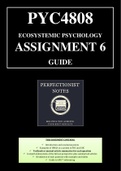Essay
BTEC Applied Science Unit 4, Assignment B (FULL ASSIGNMENT)
- Institution
- PEARSON (PEARSON)
This is a BTEC Applied Science Unit 4 Assignment B that received a distinction grade. It serves as an example of work at a Distinction level, which you can refer to as a guide to help you achieve a distinction in completing your own assignment. Feel free to message me with any questions.
[Show more]













